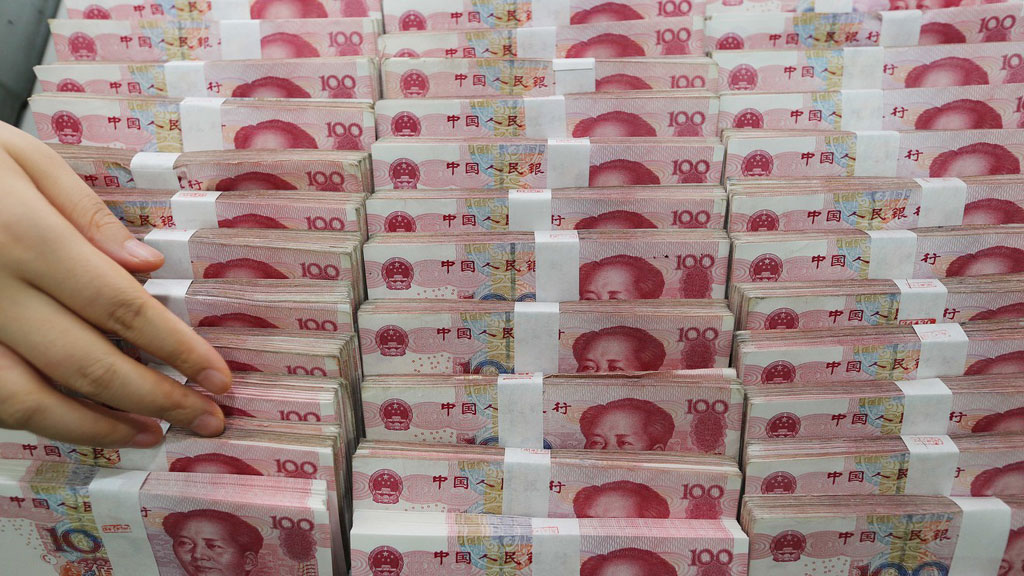 SHANGHAI/HONG KONG: China's yuan firmed against the dollar on Tuesday after falling to seven-week lows the previous session, as a liquidity squeeze in the offshore yuan market in Hong Kong helped stabilize sentiment.
SHANGHAI/HONG KONG: China's yuan firmed against the dollar on Tuesday after falling to seven-week lows the previous session, as a liquidity squeeze in the offshore yuan market in Hong Kong helped stabilize sentiment.
The spot market opened at 6.9257 per dollar and was changed hands at 6.9235 at the 4.30 pm official market close, slightly firmer than the previous late session close of 6.9285.
Stephen Innes, head of trading APAC for OANDA, said the relative calm on Tuesday was "a pause on the bumpy road to 7" per dollar.
Although the market expects the yuan to trend lower in the backdrop of a broadening Sino-US trade war and surging US Treasury yields, some analysts warn that expectations of one-way yuan depreciation could trigger capital flight and jeopardize China's growth.
"It seems the market is not ready to embrace the RMB weakening to above 7 level in the rest of this year," wrote Ken Cheung, strategist at Mizuho Bank Ltd.
"Mitigating the adverse impact of RMB depreciation and achieving the soft-landing of RMB depreciation will be the top priority task" for the People's Bank of China, he said.
On Monday - the first trading day in China following a weeklong holiday - the yuan hit its lowest official close in seven weeks after a cut in bank reserve requirements (RRR) raised expectations of further yuan weakness, in part fuelled by concerns the Sino-US trade war is weighing on the economy.
But sentiment stabilized on Tuesday, even as the People's Bank of China set the midpoint rate at 6.9019 per dollar prior to market's open, fixing the yuan above the 6.90 handle for the first time since May 2017.
OFFSHORE LIQUIDITY SQUEEZE
In Hong Kong, the overnight cost of borrowing offshore yuan surged by 326 basis points to 5 percent on Tuesday, the highest level since late May, amid signs Chinese state-owned banks were squeezing liquidity to make yuan-shorting more costly.
"It is no secret that local banks are buying CNH in the market, and are using FX swaps to stabilise CNH," said one head of trading at an international bank.
A second trader said that in line with previous interventions, the lenders were swapping US dollar for offshore yuan, driving up borrowing cost and guiding spot rate lower.
"We've seen this before. When the authorities try to move the offshore market, they squeeze offshore forwards markets to make the rates high, which makes shorting the currency more expensive," said a cross-asset strategist.
Mizuho's Cheung said that the CNH liquidity squeeze will be the most likely policy tool to stabilize RMB sentiment in the near term, as China needs easing policies to support its economy, while direct foreign intervention would offset the liquidity injection released by RRR cuts.
He added though that the RMB depreciation pressure remains elevated on the US dollar rally, surging US treasury yields and softening China growth outlook.
Forward rates are already factoring in further weakness in the yuan. The offshore one-year non-deliverable forwards contract (NDFs) traded at 7.0405, roughly 2 percent below the mid-point.
One-year NDFs are settled against the midpoint, not the spot rate.
A commentary in the Global Times, a state-backed Chinese tabloid, called for strong stimulus measures to support growth.
The offshore yuan was trading 0.07 percent away from the onshore spot at 6.9244 per dollar.






















Comments
Comments are closed.